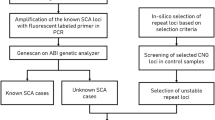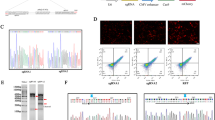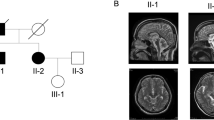Abstract
Spinocerebellar ataxia type 6 (SCA6) is a common cause of dominantly inherited ataxia due to an expansion of the CAG repeat in the CACNA1A gene. Affected individuals from the same population share a common haplotype, raising the possibility that most SCA6 cases have descended from a small number of common founders across the globe. To test this hypothesis, we carried out haplotype analysis on SCA6 families from Europe, South America and the Far East, including an established de novo SCA6 expansion. A core CACNA1A disease haplotype was found in affected individuals across the globe. This was also present in the unaffected father of the de novo case, suggesting that the shared chromosome predisposes to the CAG repeat expansion at the SCA6 locus. The SCA6 expansion lies within a CpG island, which could act as a cis-acting element predisposing to repeat expansion as for other CAG/CTG repeat diseases. Polymorphic variation in this region may explain the high-risk haplotype found in SCA6 families.
Similar content being viewed by others
Log in or create a free account to read this content
Gain free access to this article, as well as selected content from this journal and more on nature.com
or
References
Schols L, Kruger R, Amoiriddis G : Spinocerebellar ataxia type 6: genotype and phenotype in German kindreds. J Neurol Neurosurg Psych 1998; 64: 67–73.
Zhuchenko O, Bailey J, Bonnen P et al: Autosomal dominant cerebellar ataxia (SCA6) associated with small polyglutamine expansions in the alpha 1A-voltage-dependent calcium channel. Nat Genet 1997; 15: 62–69.
Craig K, Keers SM, Archibald K, Curtis A, Chinnery PF : Molecular epidemiology of spinocerebellar ataxia type 6. Ann Neurol 2004; 55: 752–755.
Dichgans M, Schols L, Hertzog J, Stevanin G et al: Spinocerebellar ataxia type 6: evidence for a strong founder effect among German families. Neurology 1999; 52: 849–851.
Mori M, Adachi Y, Kusumi M, Nakashima K : Spinocerebellar ataxia type 6: founder effect in Western Japan. J Neurol Sci 2001; 185: 43–47.
Terasawa H, Oda M, Morino H et al: A novel haplotype of spinocerebellar ataxia type 6 contributes to the highest prevalence in western Japan. Neurosci Lett 2004; 358: 107–110.
Verbeek DS, Piersma SJ, Hennekam EF, Ippel EF, Pearson PL, Sinke RJ : Haplotype study in Dutch SCA3 and SCA6 families: evidence for common founder mutations. Eur J Hum Genet 2004; 12: 441–446.
Neville CE, Mahadevan MS, Barcelo JM, Korneluk RG : High resolution genetic analysis suggests one ancestral predisposing haplotype for the origin of the myotonic dystrophy mutation. Hum Mol Genet 1994; 3: 45–51.
Bachinski LL, Udd B, Meola G et al: Confirmation of the type 2 myotonic dystrophy (CCTG)n expansion mutation in patients with proximal myotonic myopathy/proximal myotonic dystrophy of different European origins: a single shared haplotype indicates an ancestral founder effect. Am J Hum Genet 2003; 73: 835–848.
Saleem Q, Choudhry S, Mukerji M et al: Molecular analysis of autosomal dominant hereditary ataxias in the Indian population: high frequency of SCA2 and evidence for a common founder mutation. Hum Genet 2000; 106: 179–187.
Gaspar C, Lopes-Cendes I, Hayes S et al: Ancestral origins of the Machado–Joseph disease mutation: a worldwide haplotype study. Am J Hum Genet 2001; 68: 523–528.
Shimazaki H, Takiyama Y, Sakoe K et al: Meiotic instability of the CAG repeats in the SCA6/CACNA1A gene in two Japanese SCA6 families. J Neurol Sci 2001; 185: 101–107.
Lindquist SG, Norremolle A, Hjermind LE, Hasholt L, Nielsen JE : Meiotic CAG repeat instability in spinocerebellar ataxia type 6: maternally transmitted elongation in a presumed sporadic case. J Neurol Sci 2006; 241: 95–98.
Stephens M, Smith NJ, Donnelly P : A new statistical method for haplotype reconstruction from population data. Am J Hum Genet 2001; 68: 978–989.
Devlin B, Risch N : A comparison of linkage disequilibrium measures for fine-scale mapping. Genomics 1995; 29: 311–322.
Brinkman B, Klintschar M, Neuhuber F, Huhne J, Rolf B : Mutation rate in human microsatellites: influence of the structure and length of the tandem repeat. Am J Hum Genet 1998; 62: 1408–1415.
Zabetian CP, Hutter CM, Yearout D et al: LRRK2 G2019S in families with Parkinson disease who originated from Europe and the Middle East: evidence of two distinct founding events beginning two millennia ago. Am J Hum Genet 2006; 79: 752–758.
Yabe I, Sasaki H, Matsuura T et al: SCA6 mutation analysis in a large cohort of the Japanese patients with late-onset pure cerebellar ataxia. J Neurol Sci 1998; 156: 89–95.
Pearson CE, Nichol Edamura K, Cleary JD : Repeat instability: mechanisms of dynamic mutations. Nat Rev Genet 2005; 6: 729–742.
Libby RT, Monckton DG, Fu YH et al: Genomic context drives SCA7 CAG repeat instability, while expressed SCA7 cDNAs are intergenerationally and somatically stable in transgenic mice. Hum Mol Genet 2003; 12: 41–50.
Mangiarini L, Sathasivam K, Mahal A, Mott R, Seller M, Bates GP : Instability of highly expanded CAG repeats in mice transgenic for the Huntington's disease mutation. Nat Genet 1997; 15: 197–200.
Monckton DG, Coolbaugh MI, Ashizawa KT, Siciliano MJ, Caskey CT : Hypermutable myotonic dystrophy CTG repeats in transgenic mice. Nat Genet 1997; 15: 193–196.
Sato T, Oyake M, Nakamura K et al: Transgenic mice harboring a full-length human mutant DRPLA gene exhibit age-dependent intergenerational and somatic instabilities of CAG repeats comparable with those in DRPLA patients. Hum Mol Genet 1999; 8: 99–106.
Carbonell P, Lopez I, Gabarron J et al: FRAXE mutation analysis in three Spanish families. Am J Med Genet 1996; 64: 434–440.
Otten AD, Tapscott SJ : Triplet repeat expansion in myotonic dystrophy alters the adjacent chromatin structure. Proc Natl Acad Sci USA 1995; 92: 5465–5469.
Brock GJ, Anderson NH, Monckton DG : Cis-acting modifiers of expanded CAG/CTG triplet repeat expandability: associations with flanking GC content and proximity to CpG islands. Hum Mol Genet 1999; 8: 1061–1067.
Gardiner-Garden M, Frommer M : CpG islands in vertebrate genomes. J Mol Biol 1987; 196: 261–282.
Delgado S, Gomez M, Bird A, Antequera F : Initiation of DNA replication at CpG islands in mammalian chromosomes. EMBO J 1998; 17: 2426–2435.
Kang S, Jaworski A, Ohshima K, Wells RD : Expansion and deletion of CTG repeats from human disease genes are determined by the direction of replication in E. coli. Nat Genet 1995; 10: 213–218.
Nichol Edamura K, Leonard MR, Pearson CE : Role of replication and CpG methylation in fragile X syndrome CGG deletions in primate cells. Am J Hum Genet 2005; 76: 302–311.
Monckton DG, Neumann R, Guram T et al: Minisatellite mutation rate variation associated with a flanking DNA sequence polymorphism. Nat Genet 1994; 8: 162–170.
Acknowledgements
This study was funded by Ataxia UK. PFC is a Wellcome Trust Senior Clinical Research Fellow who also receives funding from the United Mitochondrial Diseases Foundation, a research grant from the United States Army and the EU FP program EUmitocombat and MITOCIRCLE. We thank Dr Kirsi Huoponen for supplying the SCA6 families from Finland.
Author information
Authors and Affiliations
Corresponding author
Additional information
Electronic database information
Accession numbers and URLs for data presented herein are as follows: European Bioinformatics Institute (EMBOSS), CpG plot, http://www.ebi.ac.uk/emboss/cpgplot/; National Centre for Biotechnology Information (NCBI), http://www.ncbi.nlm.nih.gov/; Online Mendelian Inheritance in Man (OMIM), http://www.ncbi.nlm.nih.gov/Omim (for SCA6 and CACNA1A); and UniSTS, http://www.ncbi.nlm.nih.gov.
Supplementary Information accompanies the paper on European Journal of Human Genetics website (http://www.nature.com/ejhg)
Supplementary information
Rights and permissions
About this article
Cite this article
Craig, K., Takiyama, Y., Soong, BW. et al. Pathogenic expansions of the SCA6 locus are associated with a common CACNA1A haplotype across the globe: founder effect or predisposing chromosome?. Eur J Hum Genet 16, 841–847 (2008). https://doi.org/10.1038/ejhg.2008.20
Received:
Revised:
Accepted:
Published:
Issue date:
DOI: https://doi.org/10.1038/ejhg.2008.20
Keywords
This article is cited by
-
Repeat length variations in polyglutamine disease-associated genes affect body mass index
International Journal of Obesity (2019)
-
The genetic bases for non-syndromic hearing loss among Chinese
Journal of Human Genetics (2009)



